The Arthritis Suit Experience: Walk a Mile in Someone Else’s Shoes
With the Arthritis Suit, I had slipped from one generation to another. There truly is no better way to empathize than walking a mile in someone else’s shoes.
Written by Stannah
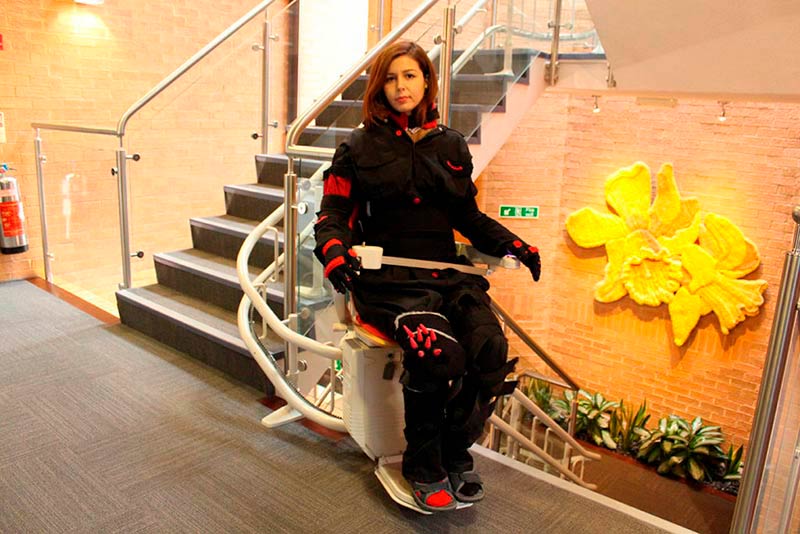
As a new member of Stannah’s International Content Team, having the chance to visit company headquarters was a wonderful opportunity to get some first-hand experience with the company’s products and corporate values.
Regardless of department, being able to empathize with our customers is crucial to developing a more accurate understanding of their needs. Therefore, there is a pressing question that every Stannah employee must ask themselves: how does it feel living with Arthritis and mobility restrictions?
How does it feel living with Arthritis?
This sort of empathy is a key factor in designing the best products for our customers. Because of this philosophy, the Arthritis Suit Experience was an important part of our International Content Team’s visit to Headquarters.
Moreover, Stannah is driven by a customer oriented culture: our goal is to offer products that match our customers’ needs. And, while the technical aspects are important, we also spend a substantial amount of time reviewing literature concerning aging, so that we can better understand and relate to our customers.
One of our primary goals is to effectively communicate with people from a diverse range of countries and cultures, a true challenge! We try to stress that prevention comes first and provide customers with useful and educational information.
So, why is it so important to highlight the struggles of the arthritic condition? According to the CDC, approximately 22% of the entire adult population in the US has been diagnosed with a form of arthritis. This condition can lead to extreme pain, stress, anxiety and even depression.
Did you know that more than 50 % of the elderly experience arthritis?
The condition is even more prevalent among seniors. Studies suggest that more than 50% of the elderly will experience arthritis at some point in their lives. Therefore, this is not an issue we can choose to ignore. Thinking about arthritis means considering the future for our parents, our loved ones, even ourselves. Moreover, it highlights the importance of preventive measures to delay the development of this seemingly inevitable condition.
50% of the elderly will experience arthritis at some point in their lives.
There is no better way to empathize with those living with arthritis than to feel it on your own skin. That is why Stannah took things a step further by creating a direct physical experience that could simulate the arthritic condition. In fact, we’ve followed the example of Ford, the first company ever to build an arthritis suit. NAPP Pharmaceuticals also had a similar design, calling their suit an “empathy-generation tool”. While Ford’s goal was to understand how cars could be made more comfortable for the elderly and NAPP was focused on empathy, Stannah uses its arthritis suit both to improve our designs and to better understand our customers.
Arthritis Suit Experience
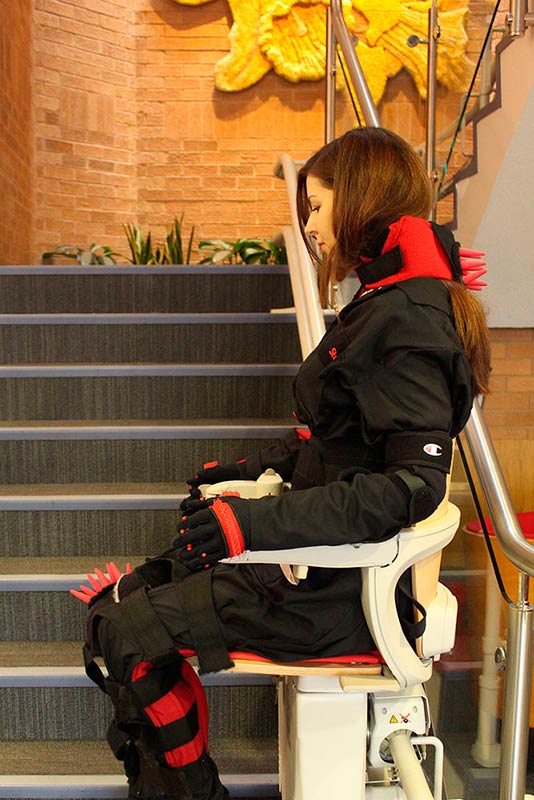
The Arthritis Suit is one of the three existing suites in the UK and was created by the Loughborough University School of Design. Stannah has been using it to help employees better understand the challenges faced by our customers with arthritis and restricted mobility. It was developed after extended research, literature review, health professional consultations and patient interviews. The suit aims at simulating some aspects of aging for people who don’t have the conditions to experience it themselves.
In a matter of seconds, I had slipped from one generation to another.
The coming of age brings reductions in joint mobility and tactile sensitivity, as well as visual changes. But how could I possibly understand this at the age of 33? Most people agree that there is no better way to develop empathy than walking a mile in someone else’s shoes. That is why our Market Insight Manager has offered me the ultimate aging experience.
In a matter of seconds, I had slipped from one generation to another. As soon as all of the suit’s components were placed, I began to feel a difference in the critical areas typically affected by arthritis.
Immediately after putting on the suit, I felt joint stiffness and discomfort. As I walked through the headquarters, I started to consider how having this condition would affect my daily life.
The suit was designed to simulate different stages and severities of arthritis, especially those felt within the joints. The red “ouch-pouches” are just symbols that represent where the wearers are more likely to feel stiffness, swelling and discomfort.
In short, these are the components of the suit:
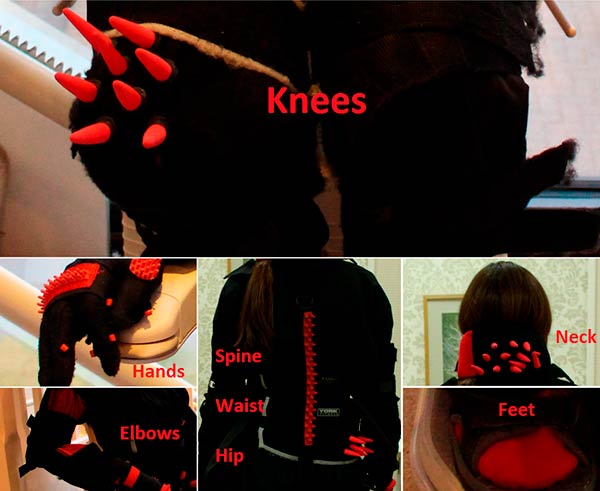
- Pebbles to simulate discomfort and crepitus at top of the spine
- Belts simulate reduced mobility
- Boning and straps simulate stiffness
- Neoprene support and straps to simulate instability
- Spikes only for visual representation (neck, spine, hip and knee)
- Discomfort over the bunion, provide discomfort standing, walking on uneven surfaces
- Gloves – stiffness in hand and fingers
Arthritis impact on daily living
Have you ever considered how it feels to struggle with arthritis?
This is a pressing question that every Stannah’s employee must ask themselves. Regardless of the department or area of work, being able to empathize with our customers is crucial to understanding our customers’ true needs. By learning what our customers go through on a daily basis, we can improve our products, so that they are truly easy to use.
When it was my turn to wear the suit, I tried to make the most of it by performing some activities that might be a part of a senior’s daily routine. Some of those tasks included:
- Going up and down the stairs:
Due to the knee stiffness, going up and down the stairs was especially painful and I felt a crepitus sensation in my joints. According to a market study done by Stannah across several European countries and the United States, joint pain is one of the main causes of mobility issues. In fact, 50% of stairlift users have joint problems and 61% of potential users also have reported knee/joint problems. Dexterity also plays an important role, as I struggled to hold on to the banister. The effort I had to make with my hands because of this lack of mobility and balance, made me realize that my knees were not the only weakness. - Eating, drinking or brushing my teeth:
Any activity that involved using my hands was extremely painful, like trying to eat or brushing my teeth. The act of grabbing an object, like a glass of water, involved pain and required care, so I wouldn’t drop it. Also, when trying to reach for something, the ribbing and the strapping on my elbow – simulating movement restriction – would prevent me from stretching my arm. - Sitting back in a chair and trying to get up:
I had significant trouble standing up after sitting for a long period, due to the hip and waist restrictions which made it more difficult to use my abdominal muscles. Also, the weakness in my knees didn’t help and my hands didn’t provide me with the confidence to get up safely. - Looking backward over my shoulder:
Whether I was standing or seated, the neck stiffness and the balance issue prevented me from looking backwards over my shoulder. I felt like the mobility restrictions and not being able to react quickly could make vulnerable to potential obstacles. - Bending to the floor:
Bending down to the floor was very difficult because of the waist and hip restrictions. The bunion on the right foot was also a mobility restrictor, causing additional discomfort and difficulty walking.
Stannah Stairlifts Room
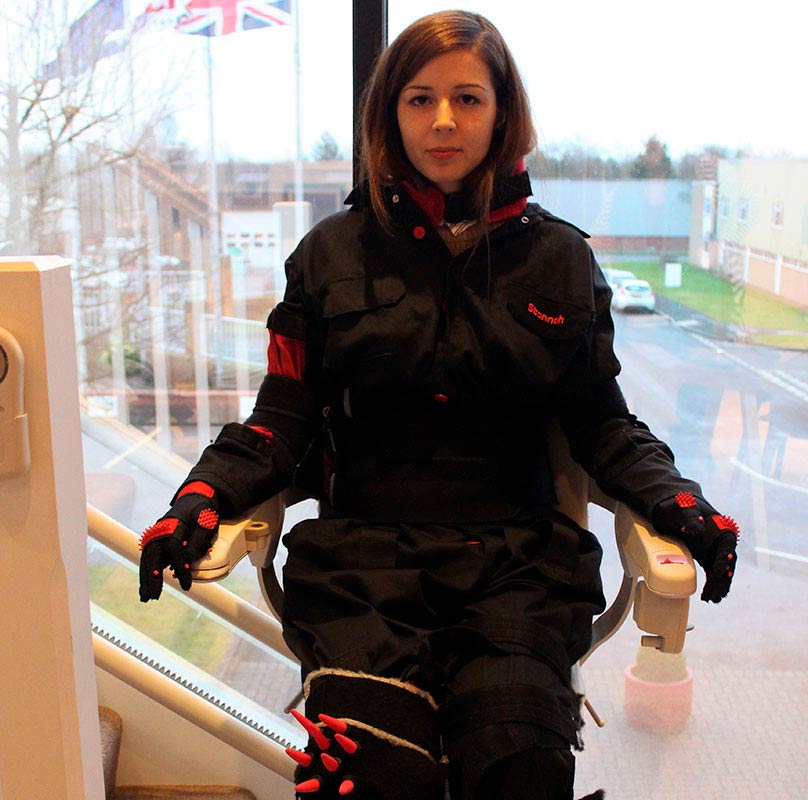
I had been wearing the Arthritis Suit for a while when we finally got to the Stannah Stairlifts showroom. The room included different scenarios, to simulate different homes, with different stair shapes and different stairlift solutions.
I was eager to try the stairlifts because I was in pain. But first, I thought it would be better to try to get up and down the stairs a couple more times, so I could really feel the difference later. My knees hurt from the effort of going up and down, but also my hands, because it was painful to hold the banister. I didn’t feel safe or confident at all. I felt that I didn’t have enough strength and balance to stop at the top of the stairs without being afraid of falling.
At last, the time had come to use the stairlifts. Before getting into the chair, I used the automatic footrest fold button and thought, “I don’t even have to bend!” Then, when I finally sat down, I thought of how comfortable the seat was and how easy it was to use the seat belt, since I didn’t have to apply any pressure (unlike a car seatbelt, for example). After a few smooth rides, up and down the stairs, I concluded that if so many of these daily tasks are a struggle, why should the stairs be another obstacle?
While riding the stairlift, I felt that I was resting my knee joints and saving my hurting hands from the effort of using the banister. I felt safe.
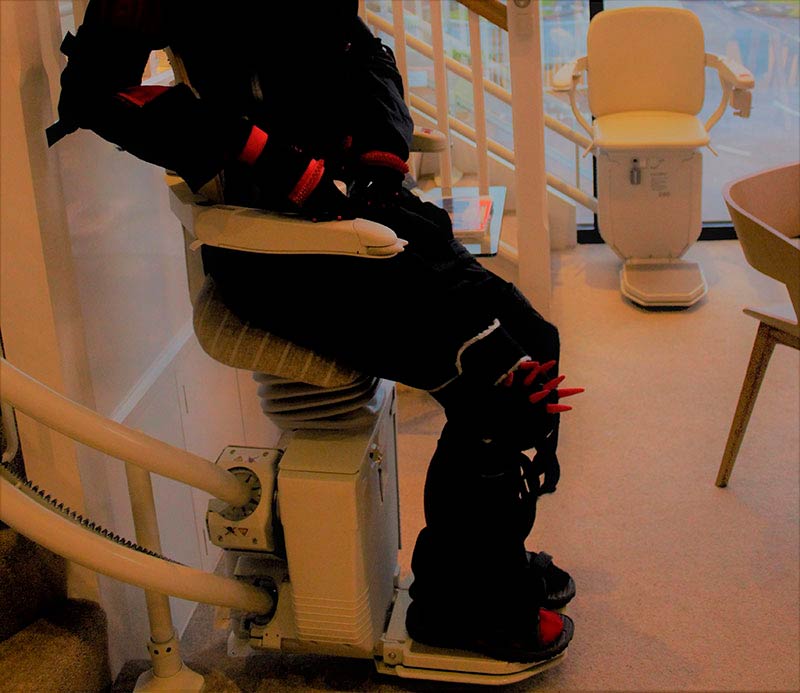
I tried the Starla, Siena and Sadler models. I felt comfortable in all of them: no bending down needed because of the automatic footrest and no stress on my hands because of the ergonomic seatbelt. However, since the suit was simulating an extreme case of overall body arthritis, I felt that Sadler was the most appropriate for my condition. Because it helps users to maintain a more upright posture, which helped minimize the effort of bending to sit and getting up.
From my personal experience, Sadler was perfect because it was tailor-made for people with limited flexibility in their joints and especially in the hips and knees.
So, from my personal experience, Sadler was perfect because it was tailor-made for people with limited flexibility in their joints and especially in the hips and knees. I felt it had the right angle, upholstery and overall design structure to provide me with the comfort I needed. Even better, it’s available in different heights, to suit both taller and shorter people.
I was amazed with all the research Stannah has undertaken to improve its designs. The company has put in a lot of work with occupational therapists and doctors, so that our products can meet the highest standards for our customers.
By the end of the day, I felt this was also an emotional journey. I now understand how coping with pain, limitation, frustration and dependency may affect our elders psychologically.
For this reason, I felt very proud to be part of the Stannah family, where working to make life easier for those with restricted mobility is taken very seriously. Overall, I felt happy to work at a company that is sensitive to the struggles of those suffering from arthritis, by raising awareness about this disease and shaping our products in line with our customer’s needs.
Read More:
- Aging in Place: Breaking Down the Barriers
- What to Do When Stairs Become a Problem?
- Stairlifts for the elderly
- The Work Behind Your Stannah Stairlift
